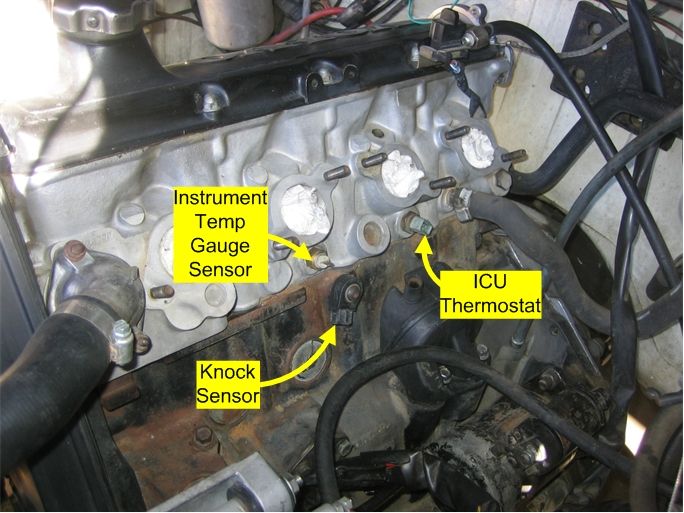|
Hi martnplyr,
Socket 6 (EZK Ignition ECU) fault code 2-2-4 nothing no connection to the dash display coolant temp gauge and your bypass repair of the temp faker board. Congrats on the repair. Have yet to repair the same.
Oh, I see, we've treated this subject before for you:
https://www.brickboard.com/RWD/volvo/1636188/220/240/260/280/volvo_240_still_dies_driving.html
Was wondering why Art has yet to reply.
I do not know whether socket 6 (EZK Ignition ECU) fault code 2-2-4 causes a check engine light. The corresponding LH-Jetronic fault code of 1-2-3, missing or faulty ECT sensor signal, DOES illuminate the check engine light.
And the problem persists?
A quick engine start, run, and quit may be CPS, fuel injection relay, AMM, and TPS in no order. Art provides some AMM testing and other guidances for you in your earlier thread. You've jumped fuses and made the fuel pumps run for a suatined period. (And you keep a charged car battery, well, charged.)
As you know, your 1990 Volvo 240 DL engine has two temperature gauges. Please see linked image (image on crappy, stupid, & dumbass Photobucket, so, third party cookies must be accepted in your JavaScript enabled browser):

The temperature sensor of your interest, and the wire harness connection(s) in between, is the illustrated image item labeled "ICU Thermostat". Incorrectly labeled. (The best image I could find in short order.) The item is actually a dual-thermistor engine coolant temperature (ECT) sensor used by both the LH-Jetronic fuel injection and emissions control computer (fuel injection ECU) and the EZK ignition and emissions control computer (ignition ECU).
The ECT connector ot the wire harness presents two pins at the connector. At the wire harness connector, one pin electrically connects to through the engine control wire harness to the LH-Jetronic fuel injection ECU. The other pin electrically connects to the EZK ignition ECU.
Temperature information to the EZK ignition ECU, and I'm unsure, may alter the dwell (duration) of spark as well as timing of spark.
So, there may be fault at:
- The ECT sensor, requiring replacement (though you test before replacement)
- Wiring fault at any wire harness connection point between the ECT and the EZK ignition ECU under the glove box mounted to the bulkhead firewall in the passenger side foot well.
The ECT can fail. More so if the coolant is of an incorrect mix, or is very old, or corrosion between the ECT sensor and the thread interferes with the connection to ground.
So, you have some fault diagnosis ahead of you. That require effort, or up to 150$ hourly for some auto repair service to rip you off, get it wrong (rip you off or they are stupid)
The ECT is not easily accessible. as it is is under the air intake port manifold #3. ....
Yet we are repeating ourselves from the earlier thread treating this very same issue as you see the link above.
The CPS can be faulty before the forgiving nature of the fault tolerance of both the ECUs (fuel and ignition). A 1990 240, if it has the original CPS is probably due for replacement. Failing CPS cable insulation revealing a silver foil liner is a clue for replacement. Some factory installed CPS cables had a yellow band painted on them near the connector end. If you see a grey band, the CPS may have been replaced at least once.
A 1990 Volvo 240 may gave fault at the throttle position switch (TPS). The LH-Jetronic ECU is very forgiving for fault with this switch. Dirt and grime intrusion can cause fault. So, if properly adjusted, when you start the engine at it runs and quits, the TPS may not have proper contact. And I forget if the LH-Jet TPS switch (unless you have early LH-Jet 3.1 (using the throttle position sensor - TPS) is off (foot off gas pedal)-on (foot on gas pedal to normally accelerate and maintain speed) -off (Floorin' it, if the throttle body moves to all open, and some don't, as Art mentioned in a post before) or if it is on-off-on.
TPS position, if properly adjusted, and foot off pedal, will turn on the idle control feature and the idle air control sets the engine to idle.
Yet we can go on speculating.
When you check for faults using the OBD tester, you check both sockets 2 (fuel) and 6 (ignition). If any fault codes, repeat procedure until no new fault codes display. You know a blink code of 1 - 1 - 1 is fault code free.
Any fault codes while connected to socket 2 at the OBD tester?
Oh, now I recall my frustration with your earlier thread, linked above.
As I wrote before, I would repair what faults the OBD reports. We list several in your prior thread (linkedin above). Test, diagnose, fault-find, and correct the problems you know you already have.
Yet OBD fault code is not the whole truth. Some items may be at fault the OBD cannot report on. Also, indeed, the CPS may be at fault and the OBD may not report on it.
The list of fault-inducing sensor, devices, and configurations on a your 1990 Volvo 240 that cause a engine start and quit condition are well-listed over the years in innumerable threads.
SO, I suggest you get real handy with that multimeter and test light methods. Very engine control wire harness continuity (like the connector at the ignition power stage, as fault at this connection can not ever be reported in the OBD).
In that so aforementioned post, you have a link to the Volvo Wiring Diagrams web site. Go check it out.
Hope that helps.
Signing off.
Dud.
--
Give your brickboard.com a big thumbs up! Way up! - Roger Ebert.   
|



